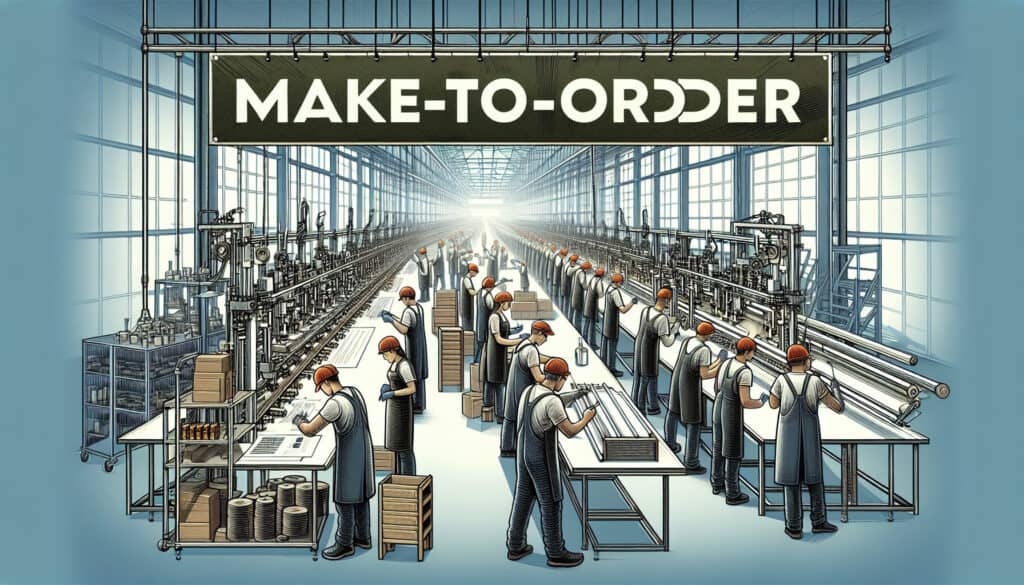To produce a product only after a customer has placed an order.
- المنهجيات: الهندسة, الجودة
Make-to-Order (MTO)

Make-to-Order (MTO)
- التصنيع المضاف, في الوقت المحدد (JIT), التصنيع اللين, تصميم المنتج, تطوير المنتجات, سلسلة التوريد, ممارسات الاستدامة, القيمة المقترحة
الهدف:
كيفية استخدامه:
- A manufacturing strategy where production is initiated only after a confirmed customer order is received. This allows for a high degree of customization and reduces the risk of unsold inventory.
الايجابيات
- Allows for a high degree of customization; Reduces the risk of obsolescence and excess inventory.
سلبيات
- Longer lead times for customers; Can be difficult to manage fluctuating demand.
الفئات:
- لين سيجما, تصنيع
الأفضل لـ
- Producing customized products such as high-end furniture, specialized machinery, or tailored clothing.
Make-to-Order (MTO) methodology is particularly effective in industries where customer preferences vary significantly and where the demand for unique products is strong, such as aerospace, automotive, custom machinery, and fashion design. This strategy can be implemented during various project phases, from design and prototyping to production and delivery. It necessitates close collaboration between designers, engineers, and clients to ensure that specifications are fully understood and met. MTO projects often involve the use of sophisticated customer relationship management tools and flexible manufacturing systems to adapt quickly to changing requirements, ensuring that products not only meet high standards but also align with clients’ evolving needs. Participants usually include sales teams who work directly with customers, design engineers who translate requests into specifications, and production teams skilled in handling custom builds. In applications like medical devices, where each product may need to conform to specific regulatory requirements, MTO provides a pathway to compliance while serving customer-specific demands. The iterative nature of the MTO process can also drive innovation, as customer feedback from early orders can inform the development of new products and improvements to existing lines, thus promoting a culture of continuous enhancement.
الخطوات الرئيسية لهذه المنهجية
- Receive confirmed customer order with product specifications.
- Review design requirements and feasibility of customization.
- Initiate production planning and resource allocation.
- Design prototypes or mock-ups as needed for approval.
- Commence manufacturing once designs are approved.
- Monitor production progress and quality control throughout.
- Make adjustments based on feedback or changes in specifications.
- Finalize product and prepare for delivery to the customer.
نصائح للمحترفين
- Implement advanced analytics for accurate demand forecasting, allowing for better resource allocation and scheduling.
- Enhance communication between sales and production teams to ensure alignment on customization options and production feasibility.
- Invest in modular design principles to facilitate efficient customization while minimizing lead times and production costs.
لقراءة عدة منهجيات ومقارنتها, نوصي باستخدام
> مستودع المنهجيات الشامل <
مع أكثر من 400 منهجية أخرى.
نرحب بتعليقاتكم على هذه المنهجية أو المعلومات الإضافية على قسم التعليقات أدناه ↓، وكذلك أي أفكار أو روابط متعلقة بالهندسة.
السياق التاريخي
1949
1950
1950
1960
1960
1960
1960
1940
1950
1950
1958
1960
1960
1960
1960
(إذا كان التاريخ غير معروف أو غير ذي صلة، على سبيل المثال "ميكانيكا الموائع"، يتم تقديم تقدير تقريبي لظهوره الملحوظ)















منشورات ذات صلة
حاسبة METS إلى السعرات الحرارية
التحليل التلوي
تخطيط الرسائل
مخططات النموذج الذهني
الحد الأقصى لقوى الدفع والسحب المقبولة
تخطيط الاحتياجات المادية (MRP)